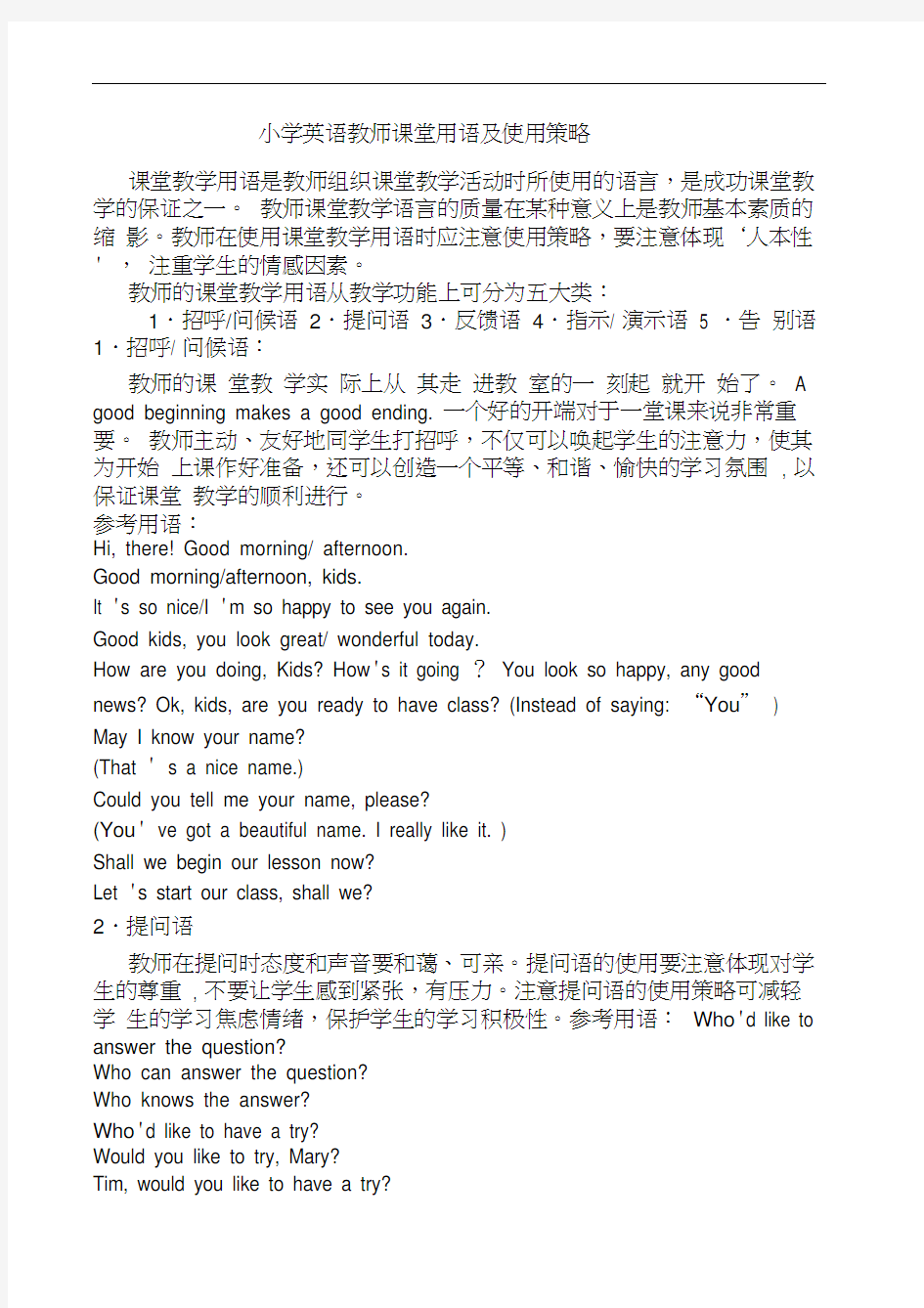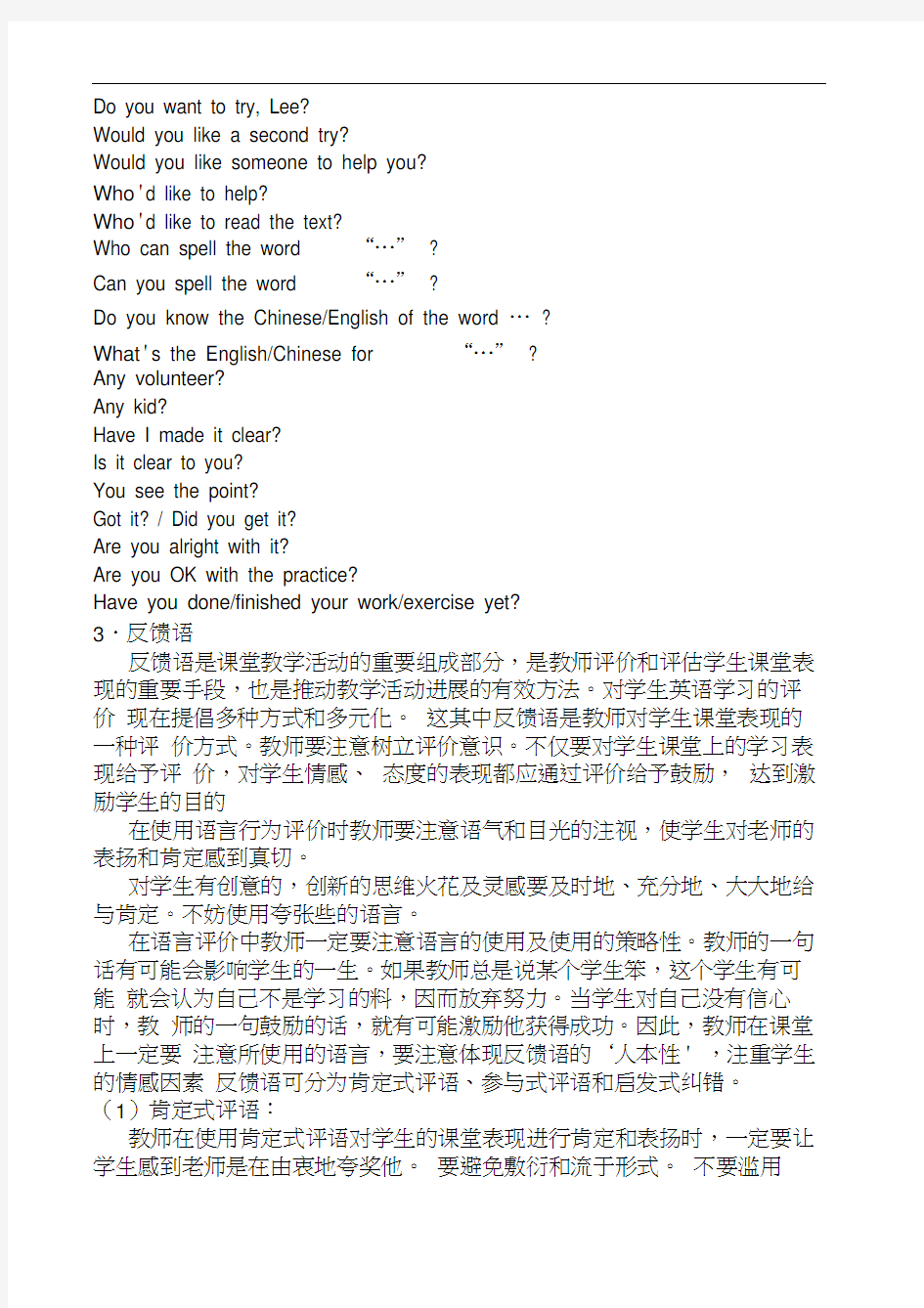小学英语教师课堂用语


小学英语教师课堂用语及使用策略
课堂教学用语是教师组织课堂教学活动时所使用的语言,是成功课堂教学的保证之一。教师课堂教学语言的质量在某种意义上是教师基本素质的缩影。教师在使用课堂教学用语时应注意使用策略,要注意体现‘人本性' ,注重学生的情感因素。
教师的课堂教学用语从教学功能上可分为五大类:
1.招呼/问候语2.提问语3.反馈语4.指示/ 演示语 5 .告别语1.招呼/ 问候语:
教师的课堂教学实际上从其走进教室的一刻起就开始了。 A good beginning makes a good ending. 一个好的开端对于一堂课来说非常重要。教师主动、友好地同学生打招呼,不仅可以唤起学生的注意力,使其为开始上课作好准备,还可以创造一个平等、和谐、愉快的学习氛围, 以保证课堂教学的顺利进行。
参考用语:
Hi, there! Good morning/ afternoon.
Good morning/afternoon, kids.
It 's so nice/I 'm so happy to see you again.
Good kids, you look great/ wonderful today.
How are you doing, Kids? How's it going ?You look so happy, any good news? Ok, kids, are you ready to have class? (Instead of saying: “You” ) May I know your name?
(That ' s a nice name.)
Could you tell me your name, please?
(You' ve got a beautiful name. I really like it. )
Shall we begin our lesson now?
Let 's start our class, shall we?
2.提问语
教师在提问时态度和声音要和蔼、可亲。提问语的使用要注意体现对学生的尊重, 不要让学生感到紧张,有压力。注意提问语的使用策略可减轻学生的学习焦虑情绪,保护学生的学习积极性。参考用语:Who'd like to answer the question?
Who can answer the question?
Who knows the answer?
Who'd like to have a try?
Would you like to try, Mary?
Tim, would you like to have a try?
Do you want to try, Lee?
Would you like a second try?
Would you like someone to help you?
Who'd like to help?
Who'd like to read the text?
Who can spell the word “…” ?
Can you spell the word “…” ?
Do you know the Chinese/English of the word … ?
What's the English/Chinese for “…” ?
Any volunteer?
Any kid?
Have I made it clear?
Is it clear to you?
You see the point?
Got it? / Did you get it?
Are you alright with it?
Are you OK with the practice?
Have you done/finished your work/exercise yet?
3.反馈语
反馈语是课堂教学活动的重要组成部分,是教师评价和评估学生课堂表现的重要手段,也是推动教学活动进展的有效方法。对学生英语学习的评价现在提倡多种方式和多元化。这其中反馈语是教师对学生课堂表现的一种评价方式。教师要注意树立评价意识。不仅要对学生课堂上的学习表现给予评价,对学生情感、态度的表现都应通过评价给予鼓励,达到激励学生的目的
在使用语言行为评价时教师要注意语气和目光的注视,使学生对老师的表扬和肯定感到真切。
对学生有创意的,创新的思维火花及灵感要及时地、充分地、大大地给与肯定。不妨使用夸张些的语言。
在语言评价中教师一定要注意语言的使用及使用的策略性。教师的一句话有可能会影响学生的一生。如果教师总是说某个学生笨,这个学生有可能就会认为自己不是学习的料,因而放弃努力。当学生对自己没有信心时,教师的一句鼓励的话,就有可能激励他获得成功。因此,教师在课堂上一定要注意所使用的语言,要注意体现反馈语的‘人本性' ,注重学生的情感因素反馈语可分为肯定式评语、参与式评语和启发式纠错。
(1)肯定式评语:
教师在使用肯定式评语对学生的课堂表现进行肯定和表扬时,一定要让学生感到老师是在由衷地夸奖他。要避免敷衍和流于形式。不要滥用
‘ Good' 有的老师过多地单一使用‘Good' 评价学生的表现,很难使学生从中受到激励,激发学习的积极性。参考用语:
Not bad. Thank you. (I ' m sure you can do better next time.)
Good!Thank you. (I could see you 've practiced a lot.)
Good kid. That ' s a good answer. Thank you.
Quite good! (I really appreciate your effort.)
Very good !(I really enjoy it.)
Great! (You did a good job.)
Excellent! (Let ' s give him/her a big hand!)
Wonderful !(I ' m so proud of you.)
Well done! (Good boy/girl/kid.)
Your answer is very good! (I admire your work.)
Nice going! (You make a great progress.) 对学生有创意的、创新的思维火花及灵感,发言中的闪光点的肯定可以使用以下的用语:
What a bright idea! Thank you.
That 's a great answer. (I really like it. )
You did a good job! (We 're so proud of you!)
Good point! (I really enjoy it.)
Good job! (I'm very pleased with your work. )
Smart! (What an adorable baby!)
Clever! (I envy you very much 。)
Perfect! ( You're very professional. )
You are such a smart boy/girl/kid!
You got sharp eyes/ears.
I couldn ' t believe my ears !
(2) 参与式评语在采用学生之间互相评价的手段时,教师要注意不要拿学生跟别人比,要拿学生同他自己比。教师可以说:同学们说某某同学说得好不好呀?进步大不大呀?在让学生参加评价时可以使用疑问和反意疑问句:Is it good?
Isn 't it a good answer?
Do you like his/her answer/reading?
Did he/she do a good job?
That 's a fantastic answer, isn 't it ?
He/she did an excellent job, didn 't he/she?
(3) 启发式纠错
当学生犯错误时,教师要避免使用否定的评价语言,如:Youare
wrong.
It 's not correct. 对回答不出问题来的学生不要简单地使用“ Sit down”,
要给他们可能获得成功的机会,鼓励他们,保护他们的学习积极性。如:That 's very close. Go on!
It 's almost right. Try again, please.
Come on! Think it over. I ' m sure you can do it.
I ' m sure you can do it if you really try. (See? You did it really well.)
Sorry, I ' m sure you can do it better next time.
I 'msorry. Would you like a second try? /Would you like to try again? Not bad. Go on, please.
Come on, It 's very close.
It doesn ' t matter. I ' m sure you can do it better next time.
非语言评价及策略
非语言评价—既运用手势,表情(眼神、面容、微笑)及其他肢体动作语言( body language ) 来对学生的学习进行的评价。在使用语言行为评价方式的同时注意非语言评价方式的使用可以加强评价效果。方式和策略:1.微笑加语言
2.用力点头-- 是一种肯定。
3.惊讶的表情+ 可表示赞赏。
5.竖起大拇指,可表示一种高度的赞赏。- 增强自信心,获得成就感。6.一只手手心朝上不断煽动四指同时说道:Yes, comeon, comeon. 或Yes, go on 。这种语言行为和非语言行为手势的同时使用,不仅对学生的发言是一种鼓励和肯定,同时还可以激励、引导学生将发言进行下去,启发学生思维。不断的启发和鼓励能够起到引导学生思维,培养思维习惯的作用。5.鼓掌- 当学生任务完成得出色时,教师可鼓掌表示赞扬。也可以号召学生一起鼓掌。掌声可以使人产生成就感,增强自信心。
6.抚摸孩子的头,拍拍孩子的肩膀也是一种鼓励性的非语言行为的评价手段。这一手段的使用会使回答正确的孩子心中荡起美孜孜的幸福感和对老
师的亲近感。这种感觉可以拉近孩子和老师的距离,拉近他们和英语课堂的距离,使他们喜欢上课并激发表达的欲望。对于回答错误的孩子,这一手段的使用可以起到安慰、消除他们心中的不安及沮丧、缓解焦虑情绪的作用。4.指示/ 演示语
在组织课堂教学时,教师使用的指示语和演示语要避免过长
和含糊不清,要力求简洁、清晰并且和蔼、可亲,避免过于生
硬。例如:Now, kids, class begins.
Now, good kids, let 's begin our class.
Today, we ' re going to learn …
Now, open your books, please. Turn to page ...
Now, kids, please look at the blackboard/picture/your books/ page five. Please read the …together. One, two, three, go!
Now, let ' s sing the song …together.
Now, let ' s enjoy the song from the tape.
Well, let ' s go on. Please look at page …
This time, you do it one by one.
Now, listen to the tape.
Now, listen to me, please.
Now, I ' ll read the … , please follow me.
Now kids, read after me/ the tape.
Follow me, please.
Just follow me, kids.
Yes, please. (To answer “ Let metry or let meanswer the question ”) Please show me how well you can do/read it.
Come to the front, please. / … please come to the front. Thank you. Thank you. Please go back to your seat.
Thank you. You can go back now.
It ' s your turn, Sue.
OK, kids, please stand up.
Please sit down.
Please do it now.
OK, go!
Please work in pairs/ in groups/ individually/ by yourselves.
Now, kids, write/put the Chinese/English under/next to each word/picture. Now, let ' s do the exercise.
Now, kids, find a partner and role-play the conversation.
Work with your partner and answer the questions.
OK, kids, time is up. Please stop working/talking now. Please stop here. Now, break time.
Let ' s have/take a break.
Good kids, be quite, please.
Now kids, here ' s your homework. Please do … and …
Don' t forget your homework. It ' s … on page …,…on page … 5.告别语课堂教学结束时教师需向学生宣布, 并向学生道别。
OK, kids, that ' s all for today. I ' ll see you next time.
Let 's call it a day today. I ' ll see you the day after tomorrow.
Alright kids. We 'll stop here today.
We'll end up the class now.
Class is over.
Class dismissed.
See you next time, kids.
See you.
See you later.
Goodbye, kids.
Bye, kids.
Wish you a good weekend.
Have a good weekend!
Have a nice day! 小学英语教师课堂用语100 句
1 Let ' s get ready for class. 准备上课。
2 I ' m sorry. I 'm late. /Excuse me for coming late. 对不起,我迟到了。
3 Please come earlier next time. 下次请早点到。
4 Class begins. 上课。
5 Who' s on duty today? 今天谁值日?
6 Is everyone here? 都到齐了吗?
7 Who' s absent today? 今天谁没来?
8 What day is today? 今天是星期几?
9 What 's the date today? 今天是几号?
10 Li Hong, have you collected all the exercise-books? 李红,作业本都收齐了吗?
11 Here are your exercise-books. Please hand them out. 这是练习本,请发下去。
12 Monitor, would you please fetch some chalk for me? 班长能帮我去拿些粉笔来吗?
13 Open your books, please. 请翻开书。
14 Please turn to Page 12. 请翻开书本十二页
15 Please take out your notebooks/exercise books. 请拿出笔记本/ 练习本。
16 No more talking, please. 请安静。
17 Attention, please. 请注意。
18 Let 's have a dictation. 让我们来听写。
19 We' re going to have a new lesson today. 今天我们要上新课。
20 First let ' s have a revision. 首先我们复习一下。
21 Who can answer this question? 谁能回答这个问题?
22 Do you have any questions? 你们有问题吗?
24 Let me see. 让我看看/ 想想。
25 Put up your hands if you have any questions. 如果有问题请举手。
26 Raise your hands, please. 请举手。
27 Hands down. 把手放下。
28 Repeat after me/Follow me. 跟我读。
29 Listen to me, please. 请听我说。
30 Look at the blackboard/screen, please. 请看黑板/ 屏幕。
31 All eyes on me, please. 请都看着我。
32 Can you solve this problem? 能做出这道题吗?
33 Let 's read it together. Ready, go! 大家齐声朗读,预备,起。
34 Read slowly and clearly. 读慢一点,清楚一点。
35 Who wants to try? 谁想试一试?
36 Who wants to do it on the blackboard? 谁愿意到黑板上来做?
37 Are you through? 做完了吗?
38 Have you finished? 做完了吗?
39 You did a very good job. 做得不错。
40 Very good./Good try./ Well done! 完成得不错。
41 Terrific!/ Wonderful! / Excellent! 很棒!
42 Please give him (her) a big hand.
请给他/ 她一些掌声
43 Can you follow me? 能跟上吗?
44 Do you understand? 你听懂了吗?
45 Don't be nervous. 不要紧张。
46 Any one can help him/ her? 谁来帮他/ 她一下?
47 Any volunteers? 谁自愿回答?
48 I beg your pardon? 对不起,能再说一遍吗?
49 Take it easy. 请放心/ 别紧张。
50 Be brave / active, please. 请勇敢/ 主动些。
51 Who wants to try? 谁来试试?
52 Come up to the front, please. 请到前面来。
53 Go back to your seat, please. 请回座位。
54 Come on. You can do it. 来吧!你能做到的。
55 Come on, you 're almost there. 来吧!你快(做/ 答)对了。
56 I ' ll give you a clue (hint). 我给你一些提示。
57 You can do it this way. 你可以这样来做。
58 Let 's play a game. 让我们玩个游戏。
59 Are you tired? Let ' s take a break. 累了吗?休息一下。
60 Look up the word in the dictionary. 在字典里查这个词。
